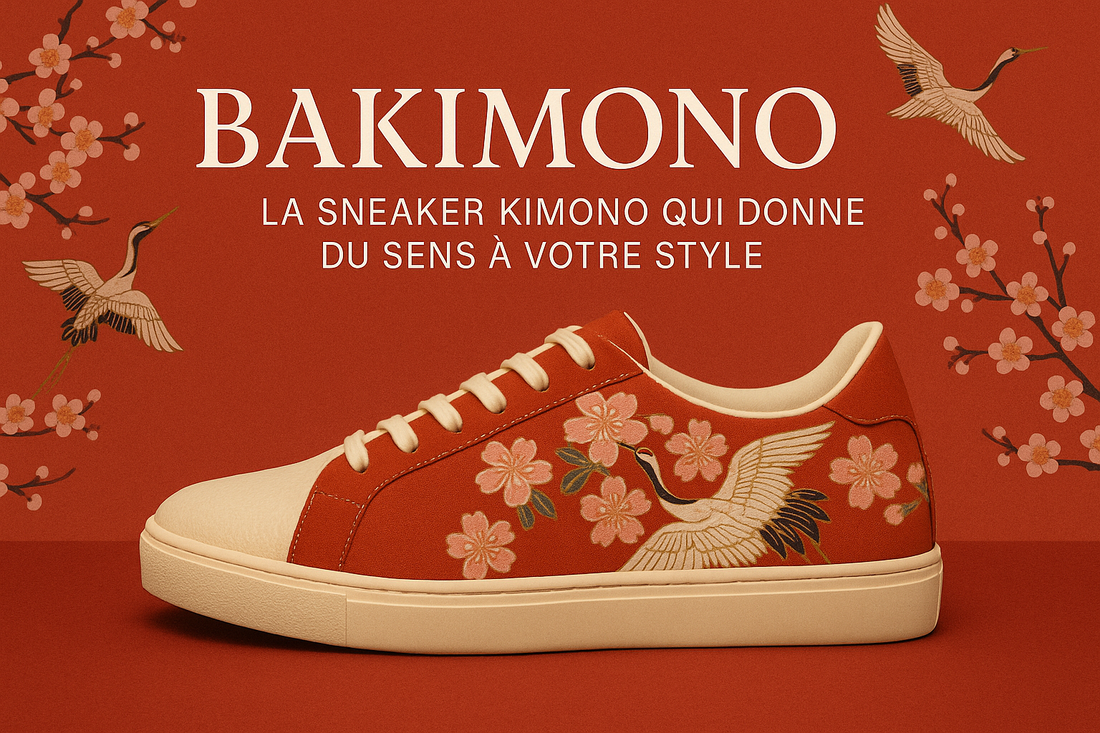
Bakimono: the kimono sneaker that embodies a symbolic universe
Share
Your Bakimonos aren't just stylish sneakers: they're walking works of art, blending culture, symbolism, and craftsmanship. Each fabric chosen tells a meaningful story, one you carry with every step.
👘 The motifs: a symbolism rich in emotions and traditions
Flowers and plants: a silent language
Sakura (cherry blossoms)
Symbol of the Japanese concept mono no aware , embodies the ephemeral beauty of life, new beginnings and sensitivity to the present moment. Perfect for marking a personal turning point.
Kiku (chrysanthemum)
Japanese imperial emblem, associated with longevity, regeneration and nobility. It also protects against evil spirits .
Botan (peony)
Nicknamed "queen of flowers", it symbolizes prosperity, good fortune, nobility and eternal beauty, while having a protective effect .
Ume (plum tree)
A winter flower heralding spring, a symbol of perseverance, inner strength and protection — often called the “peace flower.”
Kakitsubata (iris)
Linked to ancient poems, the iris evokes protection against evil spirits.
Tsubaki (camellia)
Symbol of luck, protection and sometimes love — depending on the color, it can also mean desire or hope .
Hydrangea
Emblem of patient love and family unity .
Lucky Trio: Shochikubai
Composed of matsu, take and ume (pine, bamboo, plum), it embodies winter resilience, flexibility and hope — typical motifs of the Japanese New Year .
Geometric patterns and natural elements
Seigaiha (waves) : evokes eternity, resilience and the alternation of life .
Shippo (interconnected circles) : symbolizes the seven Buddhist treasures, harmony and the universal soul .
Kikkō (hexagon) : turtle shell motif, evokes longevity and good fortune .
Karakusa (plant arabesques) : representative of growth, abundance and prosperity .
Clouds, mountains, rivers : symbols of change, stability, continuity and connection to the divine .
Animals and mythical creatures
Tsuru (crane) : mythical bird, symbol of longevity (1000 years), marital happiness and luck .
Kame (turtle) : associated with durability, wisdom and protection .
Koi (carp) : emblem of perseverance, determination and success .
Ryu (dragon) : power, protection, luck and mastery of the elements .
Kujaku (peacock) : kindness, love and openness of the heart .
Butterfly (chō) : transformation, femininity, lightness and renewal .
🎨 Colors: intensity and meaning
Each shade brings a strong emotional and symbolic dimension.
Red (aka) : color of protection, power, passion and happiness. It scares demons and marks celebrations .
White (shiro) : purity, divinity, renewal — associated with Shinto and celebrations, but also with death in Buddhism .
Blue / indigo (ao) : virginity, calm, fidelity, dignity and purity — omnipresent in traditional dress .
Black (kuro) : elegance, formality, mystery — color of the samurai and linked to mourning .
Purple (murasaki) : royalty, nobility, spirituality — reserved for the historical elite .
Gold (kin) : divinity, wealth, prestige — used in temples and ceremonial kimonos .
Green : fertility, growth, health and vitality — lucky and connected to nature .
Pink : youth, health, purity, femininity — associated with sakura and spring freshness .
Yellow/orange : joy, wisdom, love, spirituality — solar and sacred color .
Silver/Bronze : maturity, reliability, intelligence, tranquility .
🧵 Craftsmanship & ethical awareness
Each pair is handmade, using old kimonos (vintage or unsold). Upcycling values the history of the fabric while reducing waste, with the guarantee of a unique, numbered creation full of soul .
🔗 Discover your unique pair
🎴 Richly symbolic traditional fabrics
♻️ Handmade and eco-responsible
🌍 Urban style and cultural design
✨ Ready to share your story?
Don't hesitate to contact us to learn more about a symbol, color, or technique. We're here to help you find the Bakimono that resonates with your journey.
